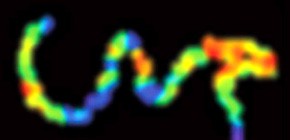
Successful observation of structural distortion, distribution of strain, in carbon nano tubes using Raman scattering microscopy
A group of researchers led by KAWATA Satoshi (Professor, Graduate School of Engineering, Osaka University) succeeded in observing, in a world first, the distribution of structural distortion/strain distribution in carbon nano tubes (CNTs) at the nano level using tip-enhanced Raman scattering microscopy. Strain was induced through an atomic force microscope tip that was dragged on the CNT, in some cases also manipulating the shape and location of the CNT. Color-coded high-resolution nanoimaging was obtained, revealing crucial information about the changes being induced in the CNT.
Their achievement is expected to contribute to the evaluation, analysis, and identification of localized variations in nano materials, technology not only for the evaluation and analysis of CNTs, but also in the production of and basic research into a variety of advanced nano materials, nano devices, and bio materials.
Abstract
Tip-enhanced Raman scattering microscopy is a powerful technique for analysing nanomaterials at high spatial resolution far beyond the diffraction limit of light. However, imaging of intrinsic properties of materials such as individual molecules or local structures has not yet been achieved even with a tip-enhanced Raman scattering microscope. Here we demonstrate colour-coded tip-enhanced Raman scattering imaging of strain distribution along the length of a carbon nanotube. The strain is induced by dragging the nanotube with an atomic force microscope tip. A silver-coated nanotip is employed to enhance and detect Raman scattering from specific locations of the nanotube directly under the tip apex, representing deformation of its molecular alignment because of the existence of local strain. Our technique remarkably provides an insight into localized variations of structural properties in nanomaterials, which could prove useful for a variety of applications of carbon nanotubes and other nanomaterials as functional devices and materials.

Figure 1

Figure 2

Figure 3
To learn more about this research, please read the full research report entitled " Tip-enhanced nano-Raman analytical imaging of locally induced strain distribution in carbon nanotubes " at this page of the Nature Communications website.
Related links :
